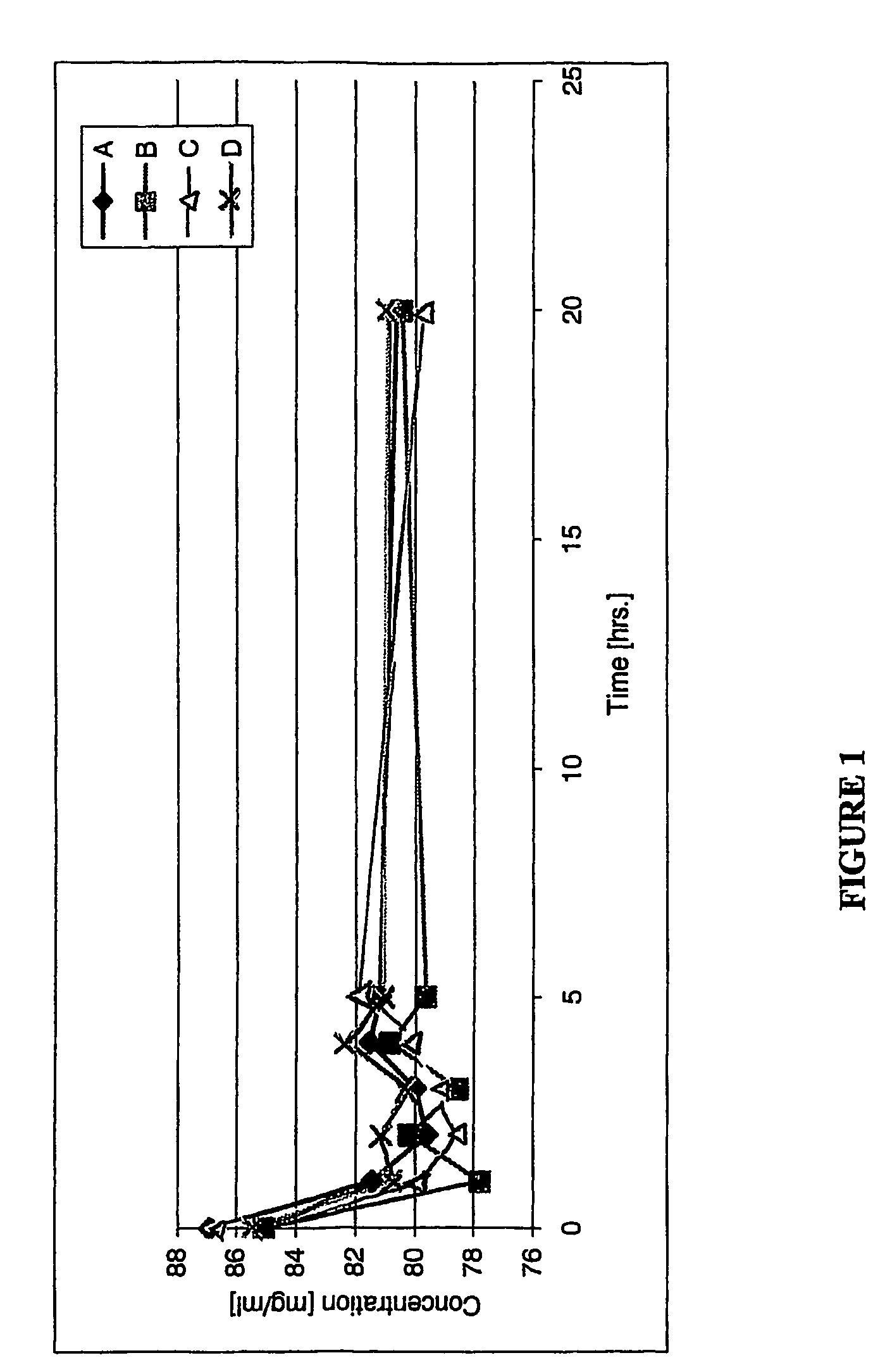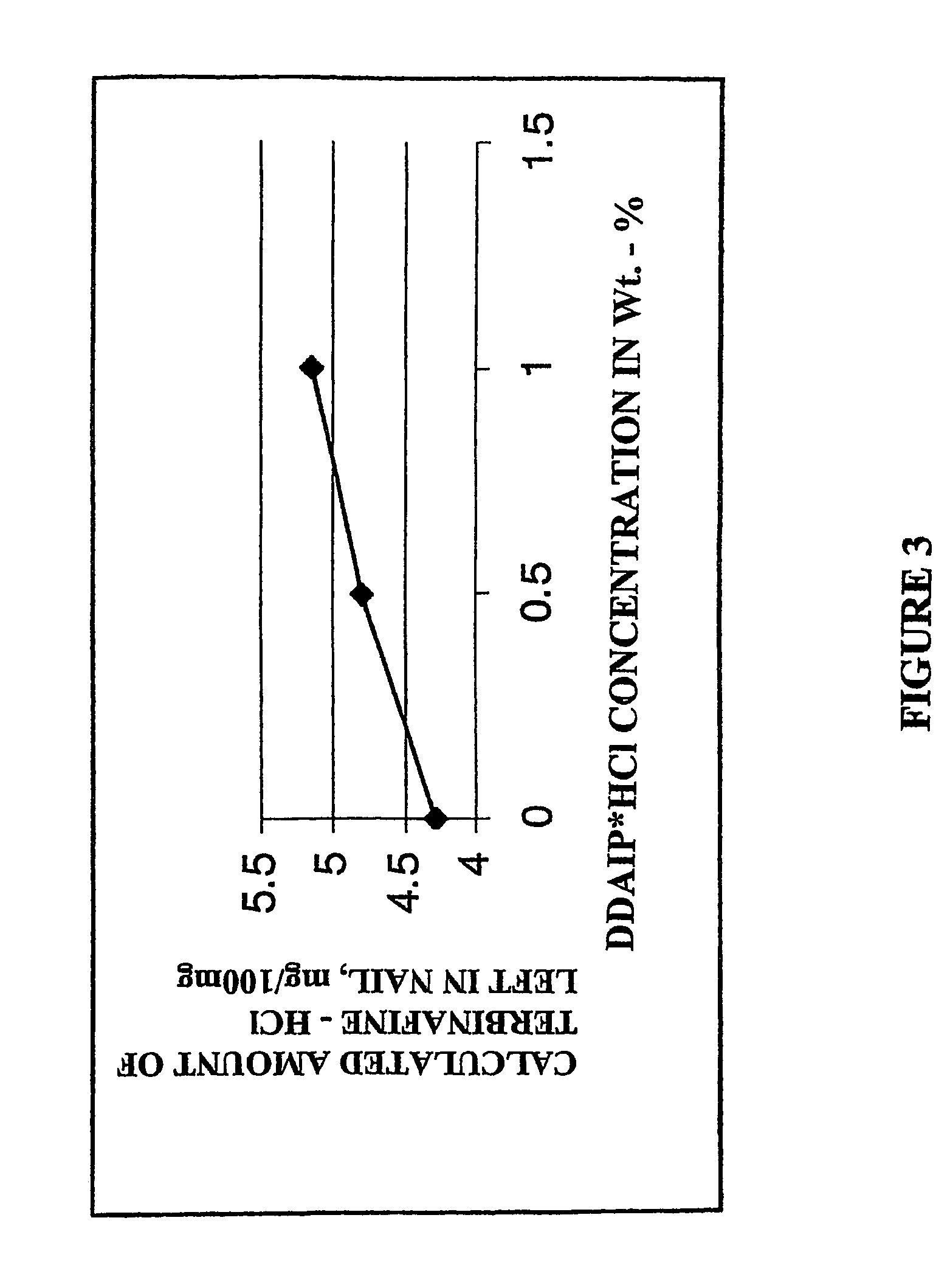Antifungal nail coat and method of use
a technology of antifungal nail coat and nail bed, which is applied in the direction of drug composition, pedicure, metabolism disorder, etc., can solve the problems of affecting the effect of antifungal agents on the daily living activities of people, affecting the effect of antifungal agents on achieving minimal effectiveness of antifungal agents through the nail bed and surrounding skin, so as to improve the efficacy of treatment, improve or prevent the effect of fungal infection
- Summary
- Abstract
- Description
- Claims
- Application Information
AI Technical Summary
Benefits of technology
Problems solved by technology
Method used
Image
Examples
example 1
[0108]The preliminary efficacy and safety of terbinafine hydrochloride in a two-coat type dual action, antifungal nail coat composition and method of this invention was studied with patients having toenail and / or fingernail fungal infection. The patients participated in an open label, single hospital pilot clinical study over a period of three months.
[0109]Up to 20 patients were selected assessed as having mild to severe onychomycosis, as measured by using a scale of infection, based on nail plate separation from the nail bed, hyperkeratosis, and discoloration. The extent of onychomycosis, hyperkeratosis, and discoloration were assessed using the following scale ratings:
[0110]Onychomycosis
[0111]0=absence of separation of nail plate from nail bed.
[0112]1=≦50% separation of nail plate.
[0113]2=>50% but ≦75% separation of nail plate.
[0114]3=>75% separation of nail plate.
[0115]Hyperkeratosis
[0116]0=absence of subungual debris.
[0117]2=thickening of ≦50% of the subungual region.
[0118]2=>50...
example 2
[0145]The uptake of antifungal agent by a nail substrate was evaluated in vitro using human nail clippings collected from one individual. The nail clippings were cleaned and extracted with anhydrous ethyl alcohol for several days before applying the antifungal agent, terbinafine hydrochloride.
[0146]About 15 mL of four antifungal containing solutions each were prepared comprising the following indicated amount, on a total composition volume basis, terbinafine hydrochloride, volatile organic carrier (ethanol), film-forming hydrophilic polymer (polyvinylpyrrolidone (PVP)), or penetration enhancer dodecyl-2-(N,N-dimethylamino) isopropionate hydrochloride (DDAIP.HCl)).
[0147]Solution A. 10 weight percent terbinafine hydrochloride in anhydrous ethyl alcohol.
[0148]Solution B. 10 weight percent terbinafine hydrochloride and 10 weight percent PVP (KOLLIDON® 30, BASF) in anhydrous ethyl alcohol.
[0149]Solution C. 10 weight percent terbinafine hydrochloride and 0.5 weight percent DDAIP.HCl in an...
example 3
[0155]The permeation of terbinafine hydrochloride by human nail clippings as a function of time was compared using Solution A and C, prepared as in Example 2. Nail clippings having a substantially similar dry thickness (+ / −5%) were selected. A selected nail clipping was anchored by being placed between two open metal frames, a sealant material was placed between the rim of the frame and the edge of the nail, and the edges of the nail were then compressed to stabilize the nail and provide a nail holder. The nail holder thus had an opening for permeation and was sealed against leakage when the anchored nail was placed in a horizontal Franz diffusion cell as a permeable membrane. The volume capacity of each of the donor cell and receiving cell was 3 mL, and the permeation area of about 78.5 square mm. The donor solution was the antifungal solution (Solution A or Solution C) and the receiver solution was anhydrous ethyl alcohol. The receiver solution was sampled periodically over a peri...
PUM
| Property | Measurement | Unit |
|---|---|---|
| weight percent | aaaaa | aaaaa |
| weight percent | aaaaa | aaaaa |
| weight percent | aaaaa | aaaaa |
Abstract
Description
Claims
Application Information
 Login to View More
Login to View More - R&D
- Intellectual Property
- Life Sciences
- Materials
- Tech Scout
- Unparalleled Data Quality
- Higher Quality Content
- 60% Fewer Hallucinations
Browse by: Latest US Patents, China's latest patents, Technical Efficacy Thesaurus, Application Domain, Technology Topic, Popular Technical Reports.
© 2025 PatSnap. All rights reserved.Legal|Privacy policy|Modern Slavery Act Transparency Statement|Sitemap|About US| Contact US: help@patsnap.com



